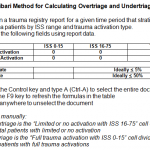Back in December I talked about the dangers of undertriaging trauma patients (click here to review). What about the opposite problem, overtriage?
First, how do you calculate your overtriage rate? It’s pretty simple. Use your trauma registry to count how many patients arriving in the ED were trauma activations but didn’t meet any criteria:
(Number of ED trauma patients who were trauma activations
but did not meet activation criteria)
——————————————————– x 100
(Total number of trauma activations)
This can only be accurately determined if the activation criteria are recorded on each patient. If not, use the following equation:
(Number of ED trauma patients who were trauma activations
with ISS <= 15)
——————————————————— x 100
(Total number of trauma activations)
Values can range from 0% to 100%. The usually acceptable overtriage rate is 50-80%. What happens when the overtriage rate is too high? You wear out your trauma team. They are being called for patients with injuries that don’t warrant it.
The solution for overtriage? Change your activation criteria, or add a second level trauma response that doesn’t require as many people to respond. This requires a thoughtful analysis of your existing criteria so you can decide what needs to be changed or discarded.
The danger? More undertriage. Over- and undertriage go hand in hand. As overtriage decreases, undertriage increases. You need to strike a balance so that the undertriage rate stays below 5%. This makes an excellent performance improvement (PI) program project!

